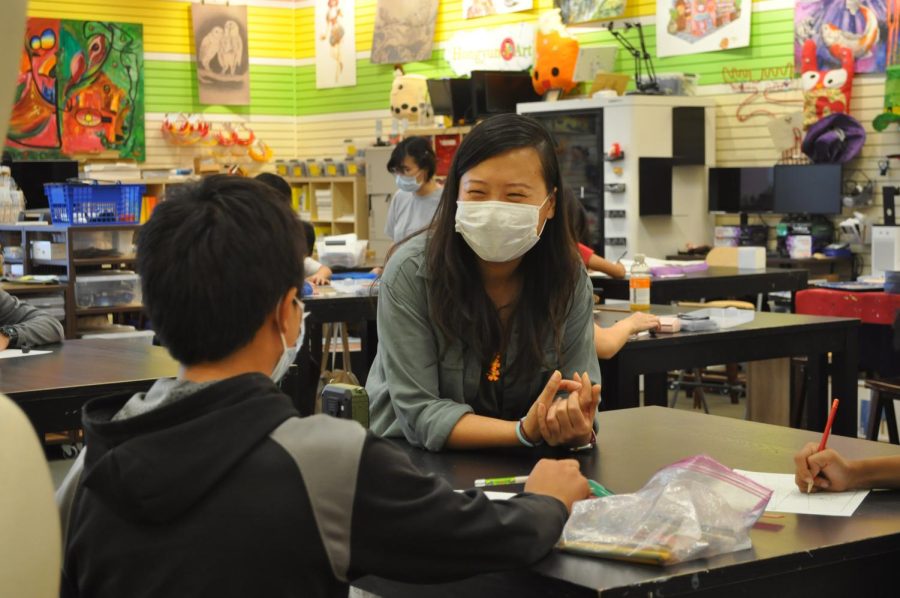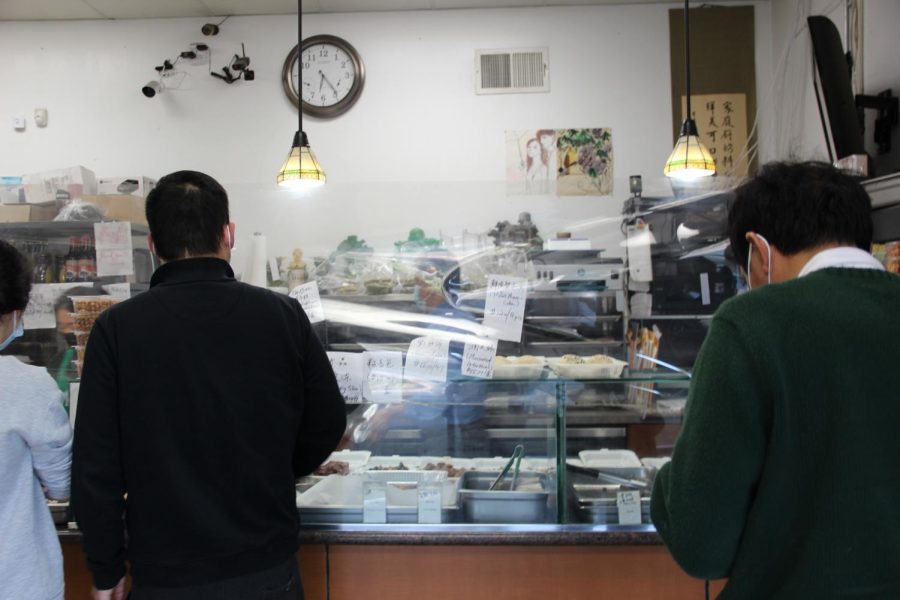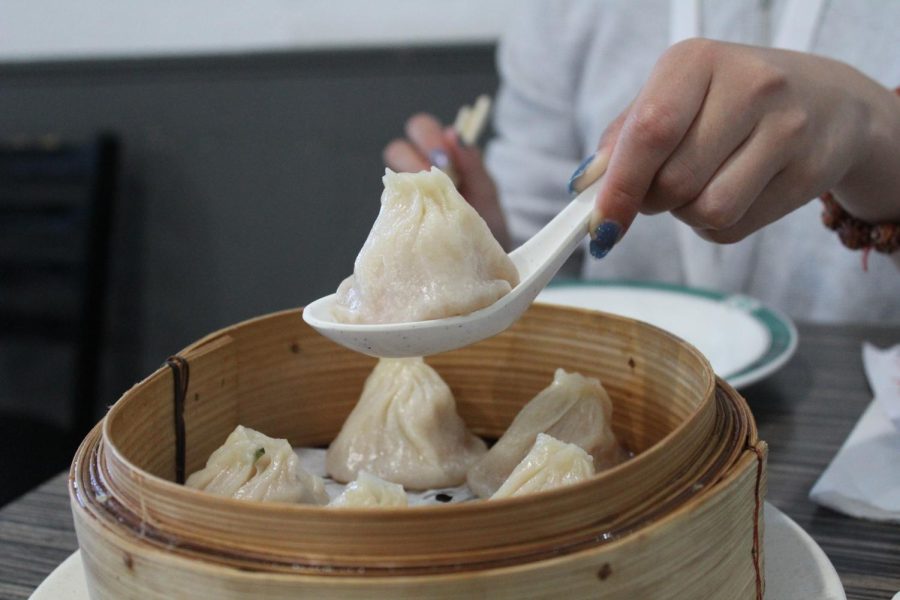Made from scratch
Tracing the stories of home owned Chinese businesses
June 19, 2022
Hongyun Art
The cloth of her drenched dress weighed down on her as she scanned her surroundings — students her age waiting as their parents held umbrellas over their heads. She on the other hand stood still, without even a raincoat to cover her. She felt out of place, scared and most of all, unpresentable. Gently lifting her canvas bag, she realized the art supplies she had bought with her red envelope money were now dripping with rainwater, unusable.
It was April, the rainy season in Shanghai, China, when 16-year-old Hongyun stood with her soaking shoes in a line with hundreds and thousands of other children. She had just come from Inner Mongolia, making this the second time she had run away from home: the first to canvas art colleges in Shanghai and this time, to take an enrollment test.
Hongyun had just enough money for a train ticket to and back from her college visits, with a total of “10 cents” in her pocket. She barely ate the entire trip and was living in a run-down motel with 12 other girls. She remembers that while standing in front of the train station, a homeless girl pitied her and eventually gave her “50 cents” after realizing that Hongyun had no money herself.
Now she was in front of Shanghai Theater Academy, her nerves eating at her as she timidly walked in. When the test administrators saw her drenched materials, they handed her dry paper and art supplies . As she walked into the exam room, she knew that she had to take advantage of this opportunity to the fullest. This test would determine her whole life.
Honyun was first introduced to the world of art by her grandpa. Long scrolls with traditional Chinese “山水” paintings lined the walls of his study room, decorated with potted flowers and accented with Chinese calligraphy brushes. He would sit in the center — his calm strokes animating an ink-borne tiger that stretched across the scroll. When she wasn’t getting him water to dip his brushes into, Hongyun sat next to him, watching him paint. She remembered thinking, “哇,好美呀,” — “Wow, how beautiful—” and would try to replicate his drawings. But while her grandfather had only pursued art as a hobby, Hongyun expressed that she wanted to pursue it beyond that. However, her parents were quick to shut her down.
“‘You are so disgraceful, you will be poor, on the end [of] the street and be homeless,’” Hongyun recalls her parents saying.
She had no other choice but to go to Shanghai on her own and take the test without telling her parents — pausing all communication with them. Her heart palpitated as she stood in front of a long winded poster that listed the names of each student that advanced to the next day — the test spanned a week, each day presenting a different task for the selected students to complete, ranging from realism to oil painting. After Hongyun completed the last day, she went home and collapsed on her bed for the entire day. Hongyun did eventually receive her acceptance letter from the Shanghai Theatre Academy— a prestigious college with a low acceptance rate, the one where “all the Chinese celebrities” were from. The college had a selective acceptance process, which would’ve given her an “iron rice bowl” job after graduation. However, during her fourth year, she felt that the atmosphere at the college didn’t suit her, and so she decided to immigrate to America.
When she arrived in America, Hongyun initially enrolled in De Anza College to refine her English, later transferring to University of California, Berkeley where she earned her master’s degree in fine art. After graduating, she was a part-time arts and crafts instructor at Eaton Elementary School. Feeling both unfulfilled and financially unstable in her new career, she decided to follow her mother-in-law’s advice and go into nursing, hoping to pursue a new and more conventional path in her family’s eyes.
It wasn’t until she threw up after seeing a cadaver, the pungent chemicals overwhelming her sense of smell, that she “realized [she] didn’t want to do this.” Hongyun promptly quit nursing school and gave herself two years to “do whatever [she] wanted to do.” She promised herself that if her endeavor failed, she would go back to nursing school.
She returned to art, her true passion Hongyun scrambled her resources together and opened a small art studio in her apartment — thus began Hongyun Art. To attract students, she and her husband Tommy designed small cut out ads that they posted on bulletin boards and printed out in the corner of newspapers.
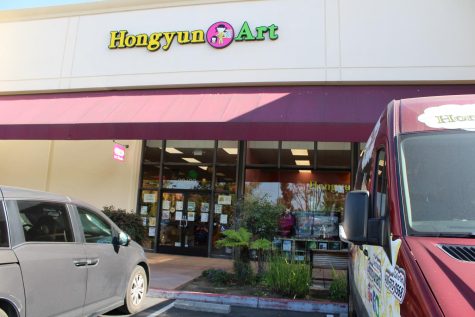
What started with two students grew rapidly through word of mouth, and Hongyun’s classes were soon booked back to back, her dream manifesting in front of her when the two opened their first location on De Anza Blvd. However, De Anza already had a line of established and bustling art studios — Hongyun remembers her friends who also owned art studios asking if she was crazy for opening her studio on the same street as them, especially during the Great Recession of 2008. This cumulated into a general nervousness that accompanies every first endeavor, a constant worry about rent exacerbated by her other concerns.
“I had no choice because my one bedroom apartment could not hold all my students,” Hongyun said. “All my classes [were] packed and people were still on the waiting list — I had no choice; I had to open a bigger space. It was very tough in the first half year, I was very scared and I just wanted to make sure everything’s right.”
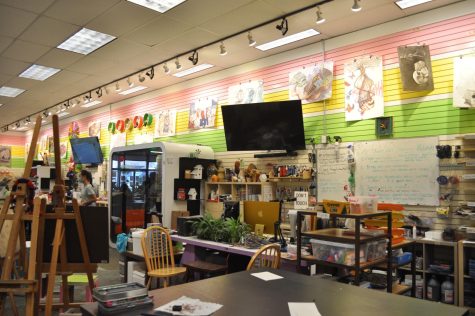
Hongyun and Tommy recall facing challenges everyday, the experience and time helping them “just get used to it.” Used to running an art studio by herself, Hongyun’s first major challenge was managing others. She also had to learn how to implement feedback training into her business and explore the physicalities of the studio as they became more resourceful — this helped when they opened their third studio, as the couple manually wired all their lights and painted their own walls. Hongyun cleverly painted splotches of paint on their carpet instead of replacing it and they upcycled an extra order of doors as tables for the studio, even using the chairs from a neighboring Chinese restaurant that was closing down.
Their hard work paid off, and their studio flourished. They soon moved into their second studio across the street from their first location in 2014. Hongyun Art moved to theCrossRoads Plaza in 2019 and focuses on hands-on creative art projects for students of any age. The owners attribute their choice to only have one studio open to their feeling that having multiple locations open at once would decrease the business’s authenticity and the personal feeling embedded into the name.
When recalling why her studio stood out and eventually thrived despite opening on a street of competing businesses, Hongyun laughed: “I never thought about why.”
Hongyun and Tommy eventually attributed it to their teaching style, their “whole mantra [being about how] art is not just about pretty pictures,” but rather the creativity and passion gained from each project. They don’t believe in training their students to be like “photocopying machines;” rather, they always foster their students’ imagination.
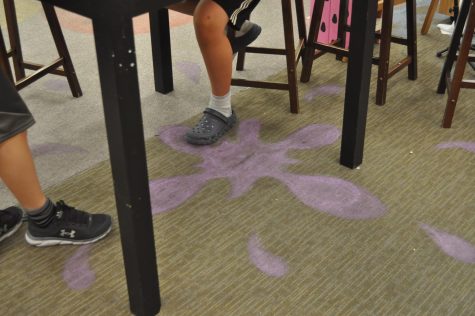
This translates through their teaching style, which includes stimulating their students’ creativity at a young age. Their art prompts have an open-ended nature, one of them being “how to send a cow to the moon,” which inspired drawings with colorful hot air balloons, spaceships and enlarged soap bubbles. With imagination, Hongyun emphasizes how there is “no right or wrong,” a concept she has seen parents unable to fully grasp.
“The honest truth is that [for the younger] kids, [their] brains are truly unlocked,” Tommy said. “As you get older people beat you down, like ‘No, that’s wrong, you can’t do that, that’s wrong and that’s wrong.’ And our job is to keep that open minded thinking alive as long as possible.”
The two also value developing personal connections with their students, making conversation about their life beyond art class — from how their week went to boyfriends or girlfriends and prom — to the point where Tommy describes it to be “like therapy.”
Hongyun emphasizes how instead of treating art as a skill, she presents it as a tool to “create new ideas and interact with each other.” The way her studio is set up with these core ideals, implementing different activities and systems that support her students.
“I use art to help kids create,” Hongyun said. “And after that, you use that to help other people.”
One program Hongyun Art uses is the Teacher’s Assistant (TA) program where students take on the role of a mentor for younger kids, because “sometimes the best way to learn is to help other kids [because they can] trigger another perspective” and improve one’s leadership skills.
Stemming from Hongyun Art, the Hongyun Art Foundation was created to give back to the community, facilitating comic workshops in Cupertino Library, senior home visits and utility box paintings across the city.
The program Hongyun is the proudest of is the Global Education Initiative (GEI). Started in the spring of 2017, the GEI revolves around international trips where Hongyun Art students visit foreign nations and help students develop their inner creativity as well as training teachers on how to utilize and take advantage of their resources — at its root giving their students more creative freedom while fostering core skills. They paused the GEI program because of COVID-19 but plan to continue it sometime this year. They’ve visited Denmark, Japan, Singapore, Korea and Thailand — the most memorable being Myanmar because of the stark differences in living conditions that brought awareness to the omnipresent privilege that the students carry with them as they return back to America.
Hongyun and Tommy recounted their stories from the GEI program — enough to make a story of itself — reminiscing on the chaos of their first trip: the language barrier, uncoordinated taxis which they solved on future trips by renting out a bus and general shock and unpreparedness of how to teach in this new environment. Their stories were laced with joy and laughter, the two of them immersed in their own world as they re-lived every trip, each person building onto the other with more details that they dug out from their core memories.
To them, Hongyun Art is more than an art studio — it’s a family where the teachers and students are all learning together. Students come in as toddlers and advance up the levels until they graduate. The owners mention their alumni frequently, describing how they still come to visit, a sense of pride reverberating in the two’s voices while they boast their past and current students’ accomplishments and recount the experiences they had through teaching them.
“It’s hard for people to wrap their brain around, but for us, art is a way of seeing the world,” Hongyun said. “A lot of art schools teach you how to draw a vase of flowers and a statue [and] we can do that too — that’s fine. It’s just more interesting [to ask] ‘what do you want to draw? Why do you want to do it? What can we unlock for you that makes you more motivated? What can we do to make you guys more driven to do crazy stuff [and] attempt crazy projects that are fun?’ That’s fundamental [and] we’ve been tinkering [to] do the right thing that makes it a better experience for everybody. My goal is now to create awesome humans, little human beings, and send them off to the world and see what they can do.”
Jenny’s Kitchen
The aroma of freshly made dumplings heightened James’ interest as he stepped into the room. He was craving the traditional Chinese dishes he had heard all about — his friend mentioned that their friend, Jenny, was starting a business from her house, and dissatisfied with the Chinese food he had previously tried, which included “a plain [bowl] of rice with water,” he visited to try her food.
Tasting each dish meticulously, James immediately loved her foods’ authenticity, realizing that “even in the USA, you can still [get] real homemade Chinese food.” She made “家庭小菜”— everyday dishes using staple ingredients such as pork and chicken. Yearning the rare genuinity he found in her cooking, he visited her frequently, their friendship blossoming through his stays. The two have now been married for more than 20 years.
James characterizes Jenny as a “genius,” a realization that began to foster during their tour in different Chinese provinces — seated at an elegant restaurant in Shanghai, Jenny claimed that she could replicate the dishes that were served, distinguishing between the different ingredients and spices intermixed.
“Jenny, you know, she just has talent,” James said. “She just loves cooking and you can not stop her. Sometimes even at midnight when she has [an] idea, she jumps off the bed and rushes to the kitchen to cook and it’s crazy.”
While running the business from home, Jenny sold dumplings, pancakes and around five to six traditional types of Chinese dishes per day. Jenny’s passion was rooted in cooking, her dreams of opening a store finally realized during the economic recession of 2008, when chains of restaurants began closing down and clearing out space. The two found an open space in an area with a large Chinese population and decided to open a restaurant there because of the cheap rent and, more importantly, their loyal set of customers.

Another motivator was that James noticed in the Bay Area, many parents are swamped with work and unable to cook their own meals. And despite the abundance of “fancy” Chinese restaurants, there were none that based itself on being homemade and authentic, so they set the precedent with Jenny’s Kitchen, creating healthy dishes and branding themselves as a place where one could come and eat everyday.
“After [my customers] try my food, they know it’s different — they never quit,” James said.
After opening their first location, they added a bakery that specialized in mooncakes and other Chinese desserts, and expanded their rotation to around twenty different kinds of hot and cold dishes per day. They also sell pre-made meals such as frozen dumplings for their customers to store and quickly prepare. However, they made sure to maintain their novel authenticity and cooking style by keeping all their dishes homemade and fresh out of the kitchen.
Jenny’s Kitchen operates as a take-out joint — their shelves are stocked with different flavored dumplings and buns, which are also found inside sets of standing fridges alongside the walls that customers can manually choose from. After shopping from the shelves, customers line up behind a buffet-style counter filled with on-display side dishes that they can supplement their meal with.
At first, running the restaurant was challenging, but the couple took it step by step, approaching the process slowly. Before the opening, the two were still part-time workers juggling their two professions during the day; Jenny was a certified public accountant and James was a teacher. He graduated from medical school in China, and taught psychology, physiology and public health. For him, transitioning to a food-based business was like “starting from zero” — he had to learn how to deal with customers and handle the business from a managerial standpoint.
“Sometimes the customer is not that reasonable, and you still have to deal with them,” James said. “They think this is not good, this is not right. But this is my style, and if you don’t like my food, next time don’t show up. I do not change for you because I have to take care of 95% or 99% of my customers — I can not handle the 100%, I can not make everyone happy. That’s not my style.”
Jenny’s Kitchen opened a second location on Park Avenue that acts as a central kitchen and is closed off to customers, but plans on slowing down expansion because they want to focus on their dishes instead. Twice a year, in summer and winter, the couple take a two-week break to “refresh” and brainstorm new dishes away from the bustling environment of their restaurant.
Jenny stays in charge of the cooking, but James still tries new dishes before they’re released, using his “picky[ness]” to decide if his customers would enjoy them too. Through running the restaurant, he’s created numerous connections with his customers, who he credits for spreading Jenny’s Kitchen by word of mouth.
“I know my customers very well because they show up every single day,” James said. “We treat my customers not like guests, [but rather] we treat them like family members. They know us, we know them, even their family members and some of their relatives [who] they bring over here. My mooncakes were shipped to New York and shipped to Chicago and shipped to Washington D.C. and Los Angeles overnight, through UPS, because their granddaughter and grandson live there and after trying some of [our food], they never forgot them — they continue to ask their grandparents to ship stuff [over.] That’s really amazing.”
XLB Kitchen
The customer is not always right.
The smoked duck Kathleen Guo had been selling for over 14 years sat on the table — her customer had just complained that it was dry, so she offered to take it off his tab. However, after ensuring that the dish was no different than it’s usually cooked, she asserted that the next time he came in, she wouldn’t serve it to him again to avoid another confrontation.
“I can’t sell the smoked duck for you,” Guo said. “Because I can’t handle which one is dry and which one is not dry. [And] if the duck is returned [again], it means I didn’t make money, but I paid [for] it.”
While Guo’s mindset seems hard in stone now, she only began fostering it when she started managing her own restaurants. Guo has worked in the service industry since she was 19, starting as a receptionist at a five-star hotel in China where she was trained that the customer was always right. Overtime, her experience culminated into steady promotions, as Guo moved her way up to assistant manager, and eventually the food banquet manager at the hotel.
“[At first,] I didn’t understand anything,” Guo said. “I just knew to be happy to work. My name is Guo Yang and my boss would always say, ‘Guo Yang’s smile is very very professional.'”
Guo worked at the hotel for almost ten years before immigrating to America in 2004 in order to be with her husband. Guo never went to college in China, so when she came to America, her job opportunities were limited — she wondered to herself, “What can I do?” She was 29 and married, so to her, college was not an option. She also didn’t have the money to pay for her tuition or compensate for her time, and she still had to pay for rent. She described that during this period of time, she just “had to live.”
She eventually took a job as a waitress at a small restaurant, describing how the language barrier — she had minimal experience with English only through interacting with foreign guests in China — caused her to struggle with the job. Her manager would never let her pick up the phone because she couldn’t fluently communicate with customers. However, Guo persisted and practiced with her customers, pronouncing the words on the menu and essentially “order[ing] for them.”
“If I can pronounce the word very [well], the customer knows what I’m saying — I can sell the dishes,” Guo said. “But if I don’t know how to say the word, the customer doesn’t know what I’m saying, and it’s hard.”
As a waitress, Guo was unfulfilled with just “clean[ing] the tables and tak[ing] the orders,” and unable to interact with guests. The staff-manager discrepancy in opinions and decisions left her feeling a loss of autonomy, culminating into a desire to “work for herself.”
Due to the popularity of Shanghai dishes and the demographics of the area, Guo decided to open Bamboo Garden in Mountain View to serve the “real dishes of China,” serving a mix of spicy and mild foods because she noticed that “young people like spicy food, but kids [can’t] eat them.”
She sold that restaurant and moved to Cupertino, where she found a more favorable location — as her last restaurant was next to a gas station — with a large Chinese population and other small businesses, opening XLB Kitchen which serves Shanghai and SiChuan Dishes, specializing in “小笼包” — Xiao Long Bao, a popular dim sum dish, because she noticed that even thought people really liked it, it was challenging to make.

Setting up the new restaurant was laborious — every aspect of the building had to be under code: the kitchen, floors and even the width of the doors were regulated. Guo had to make sure that the restaurant was perfect when the inspectors came because their signature determined if XLB Kitchen could officially open or not — if there was no signature, there was no restaurant. Guo had to wait “a long time” before she could open the restaurant, describing how her “心情很糟糕,很不好,” — her emotional state was disastrous. Since she rented the building from a landlord, she had to pay rent even when the restaurant wasn’t open, practically giving away her money until it was approved.
However, this stress was relieved when she finally opened the restaurant in 2018: business was good and she was finally relaxed and happy. But this state of contentment quickly faded away when the pandemic hit two years later. As chains of restaurants were shutting down and the customers’ reluctance to go out ate into her pay, she stayed determined, keeping XLB Kitchen open because she knew that all she needed was “only a kitchen.” With four workers by her side, they pushed through the climax of the pandemic, serving to-go because of federal orders and maintaining the restaurant.
Even though business was slow, she’s grateful for her customers who helped her economically restabilize through their generosity and tips. After the height of the pandemic subsided, Guo slowly hired back her staff of 10. Guo describes how she treats her staff with the genuine kindness that she wants to be treated with. Since she’s used to being in the staff’s position, she views issues through multiple lenses and holds herself to being a “good boss.”
From a managerial standpoint, Guo emphasizes the cruciality of being patient. She remembers how during the pandemic, some customers would cut the line snaking alongside the building, and walk in, asking where their food was. Every time, Guo would politely tell them to wait outside.
“[We make our] food one by one — It’s not fast food, it takes more time,” Guo said. “They will ask, ‘Hey why is it a long time?’ But you have to understand people’s [jobs]; it’s not playing, it’s working.”
One rule that Guo implements is that after a customer places their order, they can’t add another dish to their tab because “another customer will be waiting.” Since their kitchens are small, each dish is cooked individually in the order of the tabs, and it’s not fair to cut lines.
Even though Guo has owned a restaurant for almost 15 years, she doesn’t like cooking, joking how she never steps foot in her home kitchen. She was never taught how to cook, her only training stemmed from observing professional chefs at the hotel to help guide her at the restaurant. Presenting her calloused hands, she describes how although her job is to manage the restaurant, she still works hard and is “quick to service.”
“If no one cleans the dishes, I need to do that,” Guo said. “If no one makes the dumplings, I need to do that. Clean the floors, everything, I need to do it.”
Sometimes, Guo laments her situation, explaining how “it’s tiring” to work manually, emphasizing on how one should “use [their] head to make money and not [their] hands.” For her, there was “没办法” — no choice.
However, she still feels that she has learned a lot through her experience and believes that it helps make her a better person. One trait she emphasizes is honesty, especially in regard to a small business — “the customers and staff trust me so I must be honest.” She remembers one time, a customer gave her four one-hundred-dollar bills for a two-hundred-dollar order, leaving Guo to pause and laugh, “‘Is this a test or a [very large tip]?'”
She also learned that she needs to “发挥我的特长” — play to her strengths. This means standing her ground with stubborn customers, always making sure to “slow down,” because “just because one customer is unhappy, I can’t let everyone else be unhappy too.” But more importantly, she focuses on treating her customers and staff with respect, embodying the image of being “soft and nice.”
“For [my] Chinese restaurant, the service is [excellent],” Guo said. “Because [the customer] sees that [the] boss works hard, that’s why the staff will work hard. If the boss is very nice to the customer, then the customer will be kind [back].”


